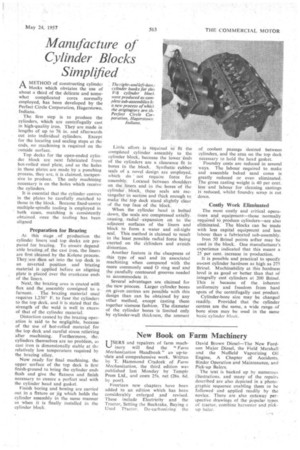Manufacture of Cylinder Blocks Simplified
Page 83

If you've noticed an error in this article please click here to report it so we can fix it.
A METHOD of constructing cylinder In blocks which obviates the use of about a third of the delicate and somewhat complicated cores normally employed, has been developed by the Perfect Circle Corporation, Hagerstown, Indiana.
The first step is to produce the cylinders, which are centrifugally cast in high-quality iron. They are made in lengths of up to 76 in. and afterwards cut into individual cylinders. Except for the locating and sealing steps at the ends, no machining is required on the outside surface.
Top decks for the open-ended cylinder block are next fabricated from hot-rolled steel plate, and as the holes in these plates are made by a punching process, they are, it is claimed, inexpensive to produce. The only machining necessary is on the holes which receivethe cylinders.
It is essential that the cylinder centres in the plates be carefully matched to those in the block. Because fixed-centre multiple-spindle tooling is employed in both cases, matching is consistently obtained, once the tooling has been aligned
Preparation for Brazing
At this stage _ of production the cylinder liners and top decks are prepared for brazing. To ensure dependable brazing,of the cast iron, the liners are first cleaned by the Kolene process. They are then set into the top deck in an inverted position and brazing material is applied before an aligning plate" is placed over the crankcase ends of the liners.
Next, the brazing area is coated with flux and the assembly consigned to a. furnade. The brazing material used requires 1,250' F. to fuse the cylinders to the top deck, and it is stated that the strength of the weld is well in excess of that of the cylinder material.
Distortion caused by the brazing operation is said to be negligible, because of the use of hot-rolled material for the top deck and careful stress relieving after machining. Furthermore, the. cylinders themselves are no problem, as cast iron is dimensionally stable at the relatively low temperature required by the brazing alloy.
Now ready for final machining, the upper surface of the top deck is first finish-ground to bring the cylinder ends flush and give the flatness and finish necessary to ensure a perfect seal with the cylinder head and gasket.
Finish boring and honing are carried out in a fixture or jig which holds the cylinder assembly in the same manner as when it is finally installed in the cylinder block.
Little effort is required tofit the completed cylinder assembly. to the cylinder block, because the lower ends of the cylinders are a clearance fit in bores in the block. Synthetic rubber seals of a novel design are employed, which do ' not require force for assembly. Located between shoulders on the liners. and in the bores of the cylinder block, these seals are rectangiilar -in section and thick enough to make the top deck stand slightly clear of the top face of the block.
When the cylinder head is bolted down, the seals are compressed axially, .causing. radial –expansion on to the adjacent surfaces of the liners and block to form a water and oil-tight seal. This method is claimed to result in the [east possible radial force being exerted on the cylinders and avoids distortion.
Another feature is the cheapness of this type of seal and its associated machining when compared with the more commonly used 0 ring seal and the carefully contoured grooves needed to accommodate it.
Several advantages are claimed for the new process. Larger cylinder bores on ,given .centres are possible with this design than can be obtained by any other method, except casting them together siamese fashion. The diameter of the cylinder bores 'is limited only by cylinder-wall thickness, the amount of coolant passage desired between cylinders, and the area on the top deck necessary to hold the head gasket.
Foundry costs are reduced in several ways. The labour required to make and assemble baked sand cores is greatly reduced or even eliminated. The gross casting weight is 40 per cent. lessand labour for cleaning castings ii reduced, whilst foundry scrap is cut down.
Costly Work Eliminated
The most costly and critical operations and equipment—those normally required to produce cylinders—are also eliminated. The blocks can be made with less capital equipment and less labour than a fabricated sub-assembly.
Iron 50 Brine' points softer may be used in the block. One inanufacturer's experience indicated that this meant a 25 per cent. increase in production.
It is possible and practical to specify asecast cylinder hardness as high as 275 Brinel. Machinability at this hardness level is as goqd or better than that of integrally cast cylinders at 200 Brine!. This is because of the inherent uniformity and freedom from hard spots of the centrifugally cast product.
Cylinder-bore size may be changed readily. Provided that the cylinder centres are the same, a wide range of bore sizes may be used in the same basic cylinder block.








































































































































